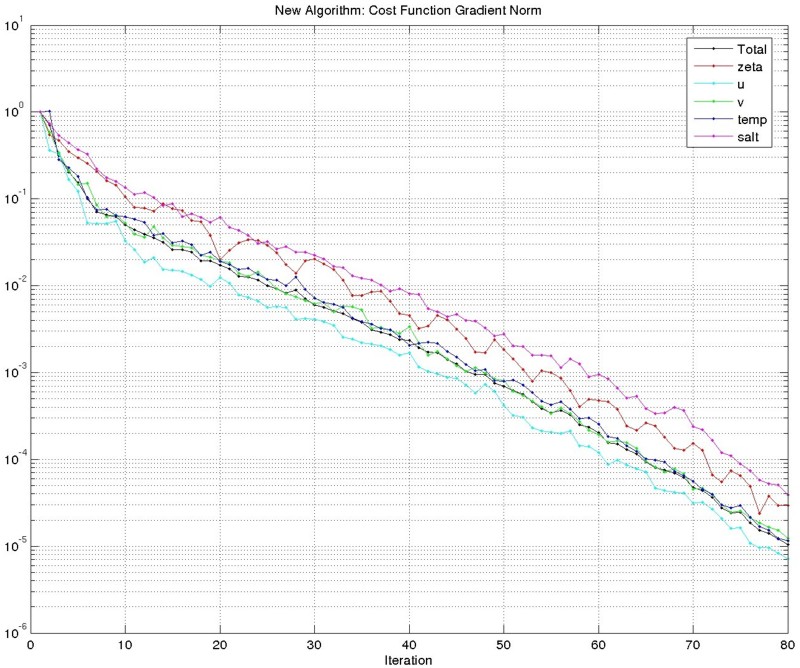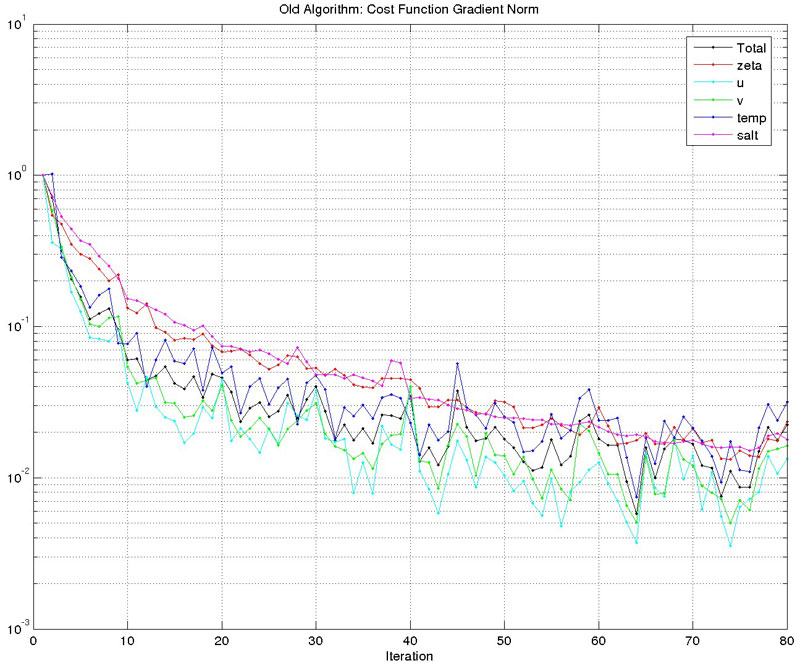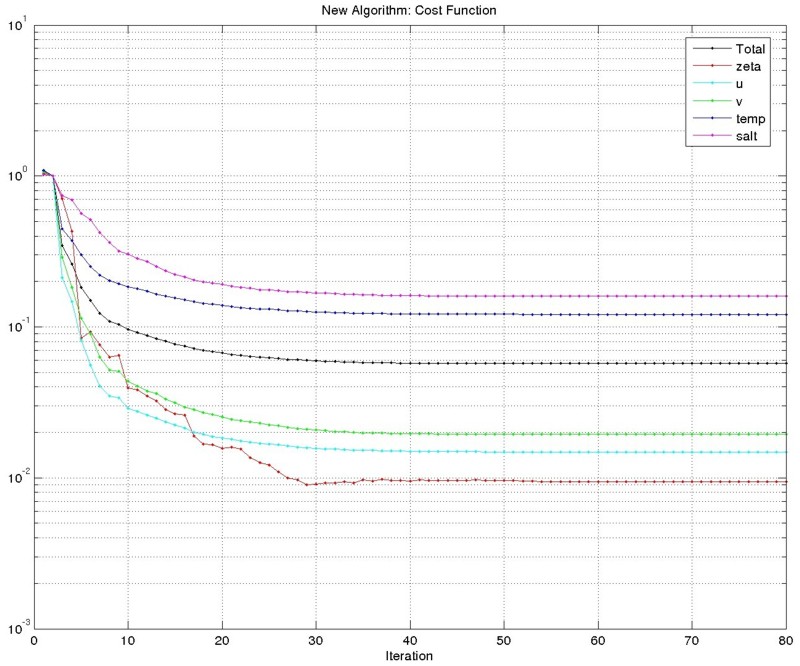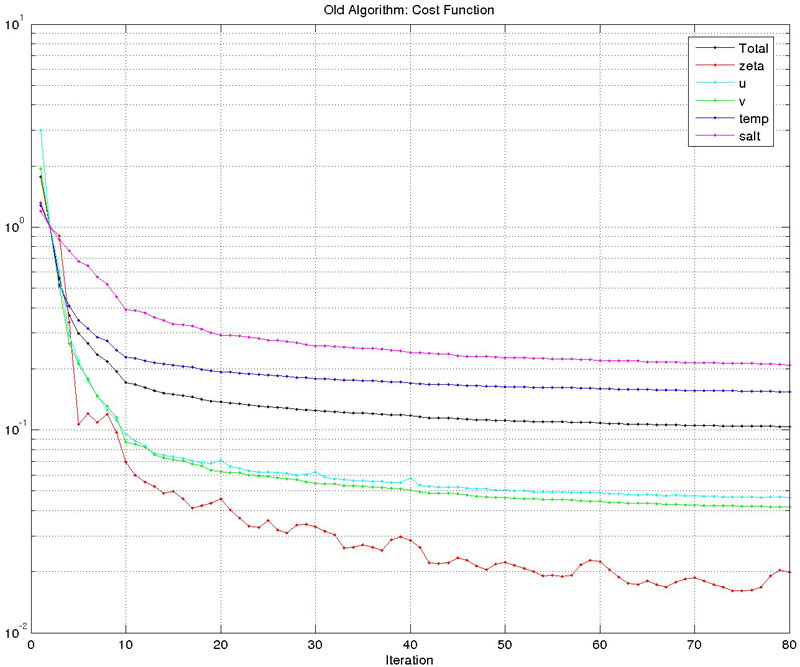I introduced the following updates to the code:
- Add new time-averaged quantities which are needed to compute eddy fluxes. For example, the tracer eddy flux is:
<H u T / n> = <H u / n> <T> + <H’ u’ t’ / n>
<H v T / m> = <H v / m> <T> + <H’ v’ t’ / m>we are interested in the last term which can be computed as:
<H’ u’ t’ / n> = <H u / n> – <H u T / n> <T>
<H’ v’ t’ / m> = <H v / m> – <H v T / m> <T>where the quantities inside <…> indicate time-averaged. In model variables, the tracer eddy flux is:
<H’ u’ t’ / n> = <Huon*t> – <Huon> <t>
<H’ v’ t’ / m> = <Hvom*t> – <Hvom> <t>all the three time-averaged quantities in the right-hand-size are now saved in the averages NetCDF file and can be activated with cpp option AVERAGES_QUADRATIC. Many thanks to John Wilkin for helping us to implement this option.
- Modified cppdefs.h in such a way that each application has it own cpp definitions include file:
/* **----------------------------------------------------------------------------- ** Include the appropriate header file for IDEALIZED APPLICATION. **----------------------------------------------------------------------------- */ #if defined A4DVAR_TOY # include "a4dvar_toy.h" #elif defined BASIN # include "basin.h" #elif defined BENCHMARK1 || defined BENCHMARK2 || defined BENCHMARK3 # include "benchmark.h" #elif defined BIO_TOY # include "bio_toy.h" #elif defined BL_TEST # include "bl_test.h" #elif defined CANYON_A || defined CANYON_B # include "canyon.h" #elif defined CHANNEL_NECK # include "channel_neck.h" #elif defined COUPLING_TEST # include "coupling_test.h" #elif defined DOUBLE_GYRE # include "double_gyre.h" #elif defined ESTUARY_TEST # include "estuary_test.h" #elif defined FLT_TEST # include "flt_test.h" #elif defined GRAV_ADJ # include "grav_adj.h" #elif defined INNER_PRODUCT # include "inner_product.h" #elif defined KELVIN # include "kelvin.h" #elif defined LAB_CANYON # include "lab_canyon.h" #elif defined LAKE_SIGNELL # include "lake_signell.h" #elif defined LMD_TEST # include "lmd_test.h" #elif defined OVERFLOW # include "overflow.h" #elif defined RIVERPLUME1 || defined RIVERPLUME2 # include "riverplume.h" #elif defined SEAMOUNT # include "seamount.h" #elif defined SED_TEST1 # include "sed_test.h" #elif defined SED_TOY # include "sed_toy.h" #elif defined SOLITON # include "soliton.h" #elif defined UPWELLING # include "upwelling.h" #elif defined WEDDELL # include "weddell.h" #elif defined WINDBASIN # include "windbasin.h" /* **----------------------------------------------------------------------------- ** Include the appropriate header file for REALISTIC APPLICATION. **----------------------------------------------------------------------------- */ #elif defined ADRIA02 # include "adriatic.h" #elif defined CBLAST # include "cblast.h" #elif defined DAMEE_4 # include "damee.h" #elif defined EAC_4 || defined EAC_8 # include "eac.h" #elif defined IAS # include "ias.h" #elif defined NATL # include "natl.h" #elif defined NENA # include "nena.h" #elif defined NJ_BIGHT # include "nj_bight.h" #elif defined NPACIFIC # include "npacific.h" #elif defined SCB # include "scb.h" #elif defined SW06_COARSE || defined SW06_FINE # include "sw06.h" #elif defined USWEST # include "uswest.h" #else CPPDEFS - Choose an appropriate ROMS application. #endifThis new design is cleaner since cppdefs.h was getting very big. I have noticed that users like to put a lot of comments in their file to document their application. The user needs now to activate the appropriate application option in cppdefs.h (for example, #define UPWELLING) and make the appropriate changes to its respective definitions file (upwelling.h). All the include files are located in the Include sub-directory. The user needs to create an include file for each different application. I wanted to do this for very long time. The feedback that I got from several of you about this was very positive.
- Several of you have been requesting for a perfect restart option in ROMS. I started coding this option. A perfect restart option is provided for the basic kernel. It can be activated with cpp option PERFECT_RESTART. This option is still under testing. I have tested this option with the upwelling example. It is run for 20 time-steps. The perfect restart fields are written at time-step 10. The RMS errors at time-step 20 between restarted and control run are:
RMS RMS RMS zeta 2.73101330e-06 2.73138360e-06 2.73142573e-06 ubar 1.50954195e-06 1.50982080e-06 1.50982771e-06 vbar 1.47805759e-07 1.47870988e-07 1.47942021e-07 temp 1.12177271e-05 1.30822796e-05 1.40771552e-05 salt 2.70888331e-05 2.90445209e-05 3.22833452e-05 u 1.50989621e-06 1.54476679e-06 1.54760557e-06 v 5.84640682e-07 1.13022193e-06 1.17730862e-06 ANA_VMIX GLS_MIXING MY25_MIXINGHowever, if PERFECT_RESTART is not activated, we get:
RMS RMS RMS zeta 1.71578595e-09 5.68765614e-09 2.07986550e-09 ubar 3.91111746e-09 4.38520664e-09 4.21003794e-09 vbar 9.83973064e-11 2.34650383e-09 1.13328922e-10 temp 4.01893636e-07 7.00800631e-05 5.55409335e-07 salt 0.00000000E+00 0.00000000E+00 0.00000000E+00 u 9.59030197e-08 1.05812267e-06 2.71992162e-07 v 2.89748763e-07 7.39400620e-07 8.01745441e-07 ANA_VMIX GLS_MIXING MY25_MIXINGObviously, this option is not working yet. Two new routines were introduced to achieve the perfect restart in a generic way: nf_read4d.F and nf_write4d.F.



